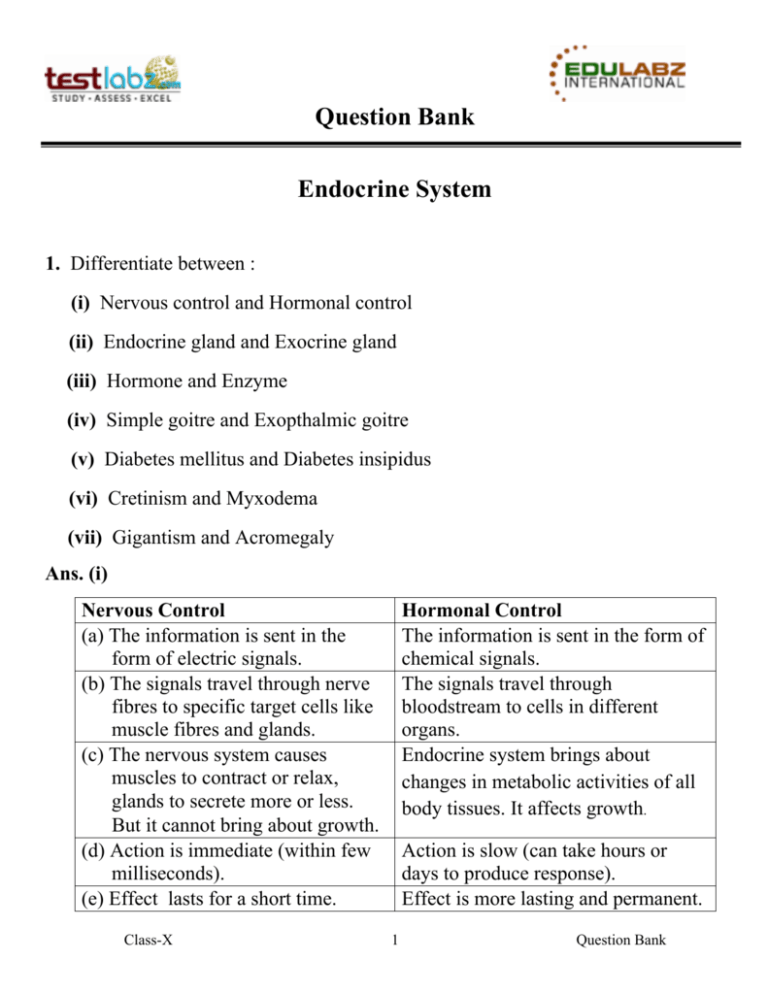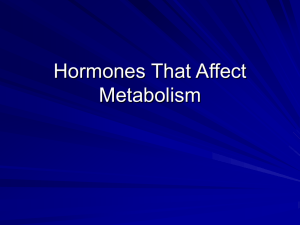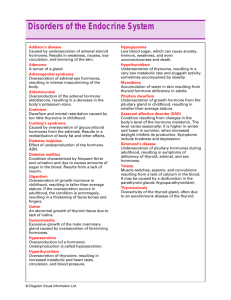Ans. - Testlabz.com
advertisement

Question Bank Endocrine System 1. Differentiate between : (i) Nervous control and Hormonal control (ii) Endocrine gland and Exocrine gland (iii) Hormone and Enzyme (iv) Simple goitre and Exopthalmic goitre (v) Diabetes mellitus and Diabetes insipidus (vi) Cretinism and Myxodema (vii) Gigantism and Acromegaly Ans. (i) Nervous Control (a) The information is sent in the form of electric signals. (b) The signals travel through nerve fibres to specific target cells like muscle fibres and glands. (c) The nervous system causes muscles to contract or relax, glands to secrete more or less. But it cannot bring about growth. (d) Action is immediate (within few milliseconds). (e) Effect lasts for a short time. Class-X Hormonal Control The information is sent in the form of chemical signals. The signals travel through bloodstream to cells in different organs. Endocrine system brings about changes in metabolic activities of all body tissues. It affects growth. Action is slow (can take hours or days to produce response). Effect is more lasting and permanent. 1 Question Bank (ii) Endocrine Glands (a) These are ductless glands. (b) They pour secretion directly into the blood. (c) They secrete hormones. (d) They control long-term activities of target organs, e.g., thyroid glands. Exocrine Glands They may or may not have ducts. The secretion is poured directly at the site of action. They secrete enzymes. They control short-term activity, e.g., gastric gland. (iii) Hormone (a) They are produced by endocrine glands. (b) Chemically they may be proteins, steroids or their derivatives. (c) They are secreted at one site and act at another. Enzyme They are produced by exocrine glands. All enzymes are proteins. They act at their site of secretion or pass through ducts to their site of action. Enzyme-mediated reactions are reversible. They act in low concentration. An increase or decrease in their concentration affects the rate of the process. They act quickly. (d) Hormone-regulated processes are not reversible. (e) They are effective in low concentration. Their undersecretion or over-secretion affects body metabolism and growth., (f) They act either slowly or rapidly. Class-X 2 Question Bank (iv) Simple Goitre (a) Caused due to the enlargement of thyroid gland because of deficiency of iodine. (b) Eyes do not bulge out. (c) Less thyroxine is produced, hence low metabolic rate. (d) It may cause decrease in body temperature, heartbeat and lack of alertness. (e) Increased intake of iodine can prevent and cure this disorder. Exopthalmic Goitre Caused due to the enlargement of thyroid gland because of hypersecretion of thyroxine. Eyes bulge out. Excessive thyroxine produced, hence increased metabolic rate. It causes rise in blood pressure and body temperature, nervousness, irritability and loss of body weight. This can be rectified by surgical removal of a part of thyroid gland. (v) Diabetes insipidus (a) This is due to under-secretion of anti-diuretic hormone. (b) It is marked by loss of excess water in urine. (c) Osmotic balance of the body is disturbed. (d) Healing power is not affected. Class-X Diabetes mellitus This is due to failure of secretion of insulin. It is marked by loss of excess glucose in urine. Total metabolism of the body is disturbed. Body’s healing capacity is impaired. 3 Question Bank (vi) Cretinism (a) Caused by hyposecretion of thyroxine in infants. (b) It is characterised by stunted growth, pot belly, protruding tongue and pigeon chest. (c) Mental and sexual retardation takes place. Myxoedema Caused by hyposecretion of thyroxine in adults. It is characterised by puffy appearance, due to accumulation of fat in the subcutaneous tissue and oedema (accumulation of water in tissue space). Mental and sexual development is not affected but patients lack alertness. (vii) Gigantism (a) Caused by oversecretion of somatotropin in childhood. (b) Due to abnormal elongation of bones and muscles, person is of abnormally large height. Acromegaly Caused by oversecretion of somatotropin after adolescence. Abnormal increase of bones of hands and legs, and the lower jaw, person has gorilla-like appearance but is not a giant. 2. Give general characterstics of hormones. Ans. (i) Hormones are produced by endocrine glands and are distributed all through the body by blood. (ii) They are information molecules or chemical regulators secreted in response to environmental changes in or outside the body. Class-X 4 Question Bank (iii) Chemically they may be large proteins (anterior pituitary hormone) or small peptides (posterior pituitary hormone) or modified amino acids (thyroid hormones) or amines (adrenal medulla hormones) or steroids (adrenal-cortical hormones). (iv) They have low molecular weight and diffuse readily through the cell membrane. (v) They regulate body functions along with nerves. (vi) They don’t catalyse specific reactions but instead help in synthesis, activation or inhibition of some enzymes in their target organs. (vii) Abnormal production (more or less production) of hormones severely affects body metabolism and growth. 3. Explain : (i) Why some women develop beard and some men develop breasts? (ii) Effects of sex hormones at puberty. (iii) People of hilly region usually develop goitre. (iv) High stature of male body than the female body. (v) Older people tend to feel more cold. (vi) Pituitary gland is called the ‘master gland’. (vii) Adrenaline is known as an ‘emergency hormone’. Class-X 5 Question Bank Ans. (i) The cause of the development of beard in females and breasts in males with normal karyotype is due to excessive secretion of sex corticoids. (ii) The sex hormones are secreted by the gonads. In males the hormones secreted are testosterone and androsterone. They are responsible for (a) normal maturation of sperms, (b) stimulation of secondary sex characters i.e. facial hair (beard), pattern of body hair, low pitch of voice (c) broadening of shoulders, (d) influence sex instinct and reflexes. In females, the hormone oestrogen stimulates the development of secondary sexual characterstics at puberty, i.e., development of hair in pubic region and in the armpits, development of breast, fat deposits in hips and high pitch of voice. (iii) People in the hilly region usually develop goitre because of the enlargement of thyroid gland. Deficiency of iodine in diet causes the thyroid to enlarge to produce inadequate amount to thyroxine. (iv) Male sex hormone stimulates the development of external male characters. It also promotes the growth of many parts of the body tissues, including bones and muscles. Since females do not have these hormones (androgens), they do not grow as tall and or have strong statue. (v) The thyroid gland regulates the body metabolism, including causing an increase in basal metabolic rate which raises the body temperature. With advancing age, the activity of thyroid gland slows down and body heat production is lowered. That is why older people tend to feel colder than youngsters. Class-X 6 Question Bank (vi) The pituitary gland is referred to as the ‘master gland, because the activities and growth of the endocrine glands and somatic cells are under the influence of secretions of the pituitary gland. Nearly 50,000 nerves fibres enter this fragment of tissue, and an enormously rich blood supply carries its hormones to the rest of the body. (viii) Adrenaline is a hormone which prepares the body to meet any emergency situation to ‘fight’, i.e., to face the danger of for ‘flight’, to run away from it, and extra energy and strength are provided to the body for the situation. Extra hormone is released into the blood at the time of emotional stress. The gland itself is stimulated by the nerve endings of the autonomic nervous systems. 4. Match the items in Column A with those in Column B. Column A (i) Diabetes mellitus (ii) Myxoedema (iii) Demineralisation of bones (iv) Addison’s disease (v) Dwarfism (vi) Cretinism (vii) Tetany (viii) Exopthalmic goitre (ix) Darkening of skin (x) Diabetes insipidus Column B (a) Hyposecretion of thyroxine in adults. (b) Hyposecretion of human growth hormone. (c) Hyposecretion of thyroxine in children. (d) Hyposecretion of parathormone. (e) Hypersecretion of Thyroxine. (f) Hyposecretion of Insulin (g) Hypersecretion of MSH. (h) Hyposecretion of vasopressin. (i) Hyposecretion of glucocorticoid. (j) Hypersecretion of parathormone. Ans. (i) (f) (ii) (a) (iii) (j) (iv) (i) (v) (b) (vi) (c) (vii) (d) (viii) (e) (ix) (g) (x) (h). Class-X 7 Question Bank 5. Given below is an outline diagram of human body showing position of certain organs. Ans. 6. Complete the following table by filling in the blank spaces numbered 1 to 10. Gland 1. ___________ Alpha cells of Pancreas 5. ___________ Lachrymal 9.___________ Class-X Secretions Oestrogen 3. ___________ 6. ___________ 7. ___________ 10. ___________ 8 Effect on body 2. ___________ 4. ___________ Protruding eyes 8. ___________ Gigantism Question Bank Ans. Gland 1.Ovary Secretions Oestrogen Alpha cells of Pancreas 5.Thyroid Lachrymal 9.Pituitary Effect on body 2. Controls secondary sexual characters 3. Glucagon 4. Raises blood sugar level by stimulating conversion of glycogen to glucose. 6. Thyroxin Protruding eyes 7. Lachrymal fluid (tears) 8. Serves as lubricants and washes away dust particles. 10. STH or GH (somato Gigantism trophic or growth hormone) 7. The hormone that releases glucose into the blood. Ans. Glucagon. 8. (a) Name the hormone produced by the thyroid gland and state its function in the body. (b) What would a child suffer from if there was hyposecretion from the thyroid? (c) (i) The three hormones produced by the pancreas. (ii) The hormones produced by adrenal medulla. (iii) The condition caused by oversecretion of insulin. Ans. (a) Thyroid gland secretes thyroxin and calcitonin. Thyroxin promotes tissue metabolism, growth and differentiation. Calcitonin promotes movement of calcium ions from blood to bones. Class-X 9 Question Bank (b) Hyposecretion of thyroid leads to simple goitre, cretinism in children and myxodema in adults. (c) (i) Three hormones produced by pancreas are insulin, glucagon and somatostatin. (ii) The hormone produced by adrenal medulla is adrenalin. It causes stimulation of sympathetic nervous system. (iii) The condition caused by oversecretion of insulin is diabetes mellitus. 9. Name the following: (a) The hormone secreted by β -cells of islets of Langerhans. (b) Hormone which increases blood sugar. (c) Hormone which causes secretion of more urine. (d) The hormone which stimulates the entire sympathetic nervous system. Ans. (a) Insulin (b) Glucagon (c) Insulin (d) Adrenalin 10. Complete the following table by filling in blank space 1 to 8: Name of gland Islets of Langerhans 3.................. 5.................. 7.................. Ans. 1. Insulin. Substance produced 1 ................. Adrenaline Thyroxine LH One important function 2................. 4.................. 6.................. 8.................. 2. Regulates blood sugar level. Stimulates deposition of extra glucose in liver as glycogen. 3. Adrenal gland. Class-X 10 Question Bank 4. Prepares the body for ‘fight’ or ‘flight’ actions by stimulating sympathetic nervous systems. 5. Thyroid gland. 6. Promotes tissue metabolism, growth and differentiation. 7. Anterior Pituitary gland. 8. Stimulates ovulation, maintenance of corpus luteum and secretion of progesterone in female and secretion of testosterone in males. 11. Why is iodine important for our body? Ans. Iodine is the active ingredient in the production of thyroxin. And thyroxin, in turn promotes tissue metabolism, growth and differentiation. Thus, it is important. 12. If you stand to make your maiden speech before a large audience, your mouth dries up and heart rate increases. What brings about these changes? Ans. The hormone responsible for this is adrenalin. It is a hormone, which prepares the body to meet any emergency situation, for “Fight” i.e. to face danger or for “flight”, i.e. to run away from it. Extra hormone is released into the blood at the time of emotional stress. Class-X 11 Question Bank 13. Compare the hormonal response with the nervous response with respect to speed. Ans. Hormonal response is slow, whereas, nervous response is immediate/ spontaneous. 14. How do endocrine glands differ from other glands? Ans. Apart from endocrine glands, there are exocrine glands. Unlike, exocrine glands, endocrine glands “secrete internally”, also called ductless glands because their secretions are poured directly into the blood and not through any special duct. These glands activate each other and work as a system of organs called endocrine system. 15. Mention any two differences between a hormone and an enzyme. Ans. (i) Hormones are secreted by glands. Enzymes are not secreted by any gland. (ii) Hormones have a direct effect on the target organs. Enzymes only catalyse the reaction, they are not used up during the reaction. 16. Do you agree with the statement — “All hormones are chemical signals”? Yes/No. Justify your answer. Ans. Yes. Hormones are transmitted chemically through blood. They can bring about specific chemical changes and regulate metabolism. They activate each other and work in a coordinated manner. As for example, the hormone insulin acts on liver and muscle cells and deposit extra glucose in the form of glycogen. Class-X 12 Question Bank 17. If one adrenal gland is removed, the other one gets enlarged to some extent. How do you explain this change. Ans. The one remaining adrenal gland performs the function of two glands. Therefore it gets slightly enlarged for enhanced secretion of hormones. 18. Given alongside is a portion from the human body showing some important structure in ventral view. (a) Where is this portion located in the body? (b) Name the structures numbered 1 – 3. (c) State one main function of each of the structures named above. Ans. (a) In the neck (b) 1 – Larynx 2 – Thyroid gland 3 – Trachea (c) 1 – Production of sound 2 – Production of thyroxine 3 – Breathing Class-X 13 Question Bank 19. Given below are two diagrams (one is correct, the other is somewhat incorrect) showing the transport of a hormone from its source gland/cell to the target organ/cell. (a) Which one has the error – A or B? _________ (b) What is the error? _______________________ [Hint : Look at all the arrows indicating the direction of flow of hormone inside blood stream.] Ans. (a) B has error. (b) Trap between gland and blood vessel. The hormone molecules are absorbed directly into the blood stream. Class-X 14 Question Bank








